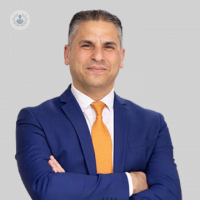Knee replacement surgery: the basics covered
Written in association with:Knee replacement surgery is a procedure which aims to alleviates pain and restores function for those suffering from severe joint damage due to conditions like osteoarthritis. Renowned consultant orthopaedic surgeon Mr Mazin Ibrahim covers why the surgery is needed, what the procedure entails, and essential follow-up care for optimal recovery.

What is knee replacement surgery, and why might someone need to undergo this procedure?
Knee replacement surgery is a procedure performed for patients suffering from conditions such as osteoarthritis, where the articulated surfaces of the knee are worn out. This deterioration causes pain and disability as the cartilage wears away and exposes the bone. The surgery aims to remove these damaged surfaces and replace them with metal components, while the structures in between are replaced with plastic, resulting in a metal and plastic implant designed to restore the knee's functionality.
The primary goal of knee replacement surgery is to relieve pain and improve function for individuals affected by osteoarthritis or other conditions impacting the articulated cartilage, such as rheumatoid arthritis or inflammatory arthritis. Additionally, it is beneficial for patients with old trauma that has damaged their articulated surfaces, leading to secondary osteoarthritis. The procedure is sometimes also performed to address instability caused by wear and tear in the knee joint. Knee replacement surgery can be either partial or total, depending on the extent of the damage.
How is knee replacement surgery performed, and what can patients expect during the procedure and recovery?
Knee replacement surgery can be performed using conventional methods or with robotic assistance. I primarily use robotic-assisted techniques for most of my knee replacements. This procedure can be either partial or total. A partial knee replacement is suitable when only one part of the joint is affected. For instance, if the cartilage in the inner compartment of the joint is worn out, we replace only that part rather than the entire joint.
However, if two or more compartments are involved, a total knee replacement is usually necessary. This involves replacing the inner and outer compartments, as well as the compartment behind the kneecap.
What can patients expect from the procedure? What is the recovery time?
The primary outcomes patients can expect from this procedure are pain relief and improved function. Most patients undergoing knee replacement surgery experience pain and disability due to joint instability. Postoperative pain is common, especially in the first few weeks, but it can be managed with pain relief measures and medication.
Patients typically recover within six weeks to three months. During this period, they need to elevate the leg, apply ice packs, and engage in movement and walking, initially with and later without the aid of crutches. A robust physiotherapy regimen is essential to prevent stiffness and help the patient regain a good level of function after the operation.
What follow-up care or lifestyle adjustments are recommended after knee replacement surgery?
After knee replacement surgery, patients do not need to make significant adaptations. The primary focus is on starting to walk immediately after the operation, as this promotes function and recovery. Initially, patients will need to use crutches, so it is important for them to learn how to use them properly. For instance, getting up and down stairs can be somewhat painful at first, but we ensure that every patient can safely navigate stairs before being discharged from the hospital. Despite this, some individuals may struggle with stairs for a few days to a few weeks, and we may recommend having a bed or toilet on the ground floor during this period.
Most of my patients manage walking and stairs without significant issues, but it is crucial to inform them of this potential difficulty. Postoperative care includes using an ice machine or any cooling device to reduce swelling. Various options are available on the market, but a simple bag of ice or frozen peas can be effective when applied to the knee while the patient is resting with the leg elevated.
Patients can generally resume their normal activities as soon as possible. However, some may find kneeling challenging, particularly in the early stages after surgery. If kneeling is necessary, we advise using pads to alleviate discomfort. Since kneeling can be painful, especially during the first few weeks, it is best to avoid it when possible. Beyond these considerations, no significant adaptations are required after the operation.
If you require knee replacement surgery, book a consultation with Mr Ibrahim via his Top Doctors profile today.


